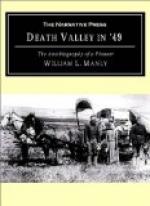It was now fifteen miles to the San Joaquin river, and a level plain lay before us. When our road turned into the river bottom we found the water too deep to get through safely, so we concluded to go on and try to find some place where we could cross. On our way droves of antelopes could be seen frolicking over the broad plains, while in the distance were herds of elk winding their way from the mountains towards the river for water. When far away their horns were the first things visible, and they much resembled the dry tops of dead pine trees, but a nearer view showed them to us as the proud monarchs of the plain.
When we came up opposite the mouth of the Merced river we concluded to try again to cross. The river here, as below, was out of its banks, and the overflowed part was quite wide which we had to pass through before we could reach the river proper.
I waded in ahead of the team and sounded the depth of the river so as not to get in too deep water, and avoid if possible such accidents as might otherwise occur. Sometimes the water was up to the wagon bed and it looked a little doubtful of our getting through in safety, but we made it at last.
We found a narrow strip of dry land along the river bank. A town was on the east side of the San Joaquin. river, just below where the Merced river came in. I think this place was called Merced City. This so-called city contained but one residence, a tent occupied by the ferryman. We crossed the sluggish stream and for the privilege paid the ferryman, ten dollars for toll. The road was not much used and the ferry business seemed lonesome.
Here we camped for the night. The mosquitoes soon found us, and they were all very hungry and had good teeth. They annoyed me so that I moved my lodgings to the ferryboat, but here they quickly found me and troubled me all night. These insects were the first I had seen since I left the lower Platte river, and I thought them as bad as on the Mississippi.
From here the road led up the Merced river near the bottom, and as we came near groves of willows, big, stately elk would start out and trot off proudly into the open plains to avoid danger. These proud, big-horned monarchs of the plains could be seen in bunches scattered over the broad meadows, as well as an equal amount of antelope. They all seemed to fear us, which was wise on their part, and kept out of rifle shot. As were not starving as we were once, I did not follow them out on the open plain, for I thought I could get meat when we were more in need.
We followed up the river bottom and saw not a single house until we reached the road leading from Stockton to the Mariposa mines, where we found a ferry and a small store. Here we learned that some men were mining a few miles up the river, so we drove on until we found a little work being done in a dry gulch near the river bank. We made our camp at this spot and had plenty of wood, water and grass. We found




